Collar (order)
This article does not cite any sources. (January 2008) |

A collar is an ornate chain, often made of gold and enamel, and set with precious stones, which is worn about the neck as a symbol of membership in various chivalric orders. It is a particular form of the livery collar, the grandest form of the widespread phenomenon of livery in the Middle Ages and Early Modern Period. Orders which have several grades often reserve the collar for the highest grade (usually called the Grand Cross). The links of the chain are usually composed of symbols of the order, and the badge (also called "decoration", "cross" or "jewel") of the order normally hangs down in front. Sometimes the badge is referred to by what is depicted on it; for instance, the badge that hangs from the chain of the Order of the Garter is referred to as "the George".
History[]
The first of the Orders of Knighthood were the military orders of crusaders who used red, green or black crosses of velvet on their mantles, to distinguish their brotherhoods. Later the members of knightly orders used rings, embroidered dragons and even garters as the symbol of their order. In the late Middle Ages the knights wore their insignia ever more prominently and medaillons, crosses and jewels in the shape of animals began to be worn on chains around the neck, known as livery collars. After the 17th century the heyday of the collar was over. They were worn only on ceremonial occasions and replaced in daily life by stars pinned to the breast, and badges suspended from ribbons. Many orders retained their collars and when orders were divided into several ranks or grades the collar was usually reserved for the highest rank. The notable exception is Portugal.

Collars of various devices are worn by the knights of some of the European orders of knighthood. The custom was begun by Philip III, Duke of Burgundy, who gave his Knights of the Golden Fleece badges depicting a golden fleece hung from a collar of flints, steels and sparks. Following this new fashion, Louis XI of France, when instituting his Order of St. Michael in 1469, gave the knights collars composed of scallop shells linked on a chain. The chain was doubled by Charles VIII, and the pattern underwent other changes before the order lapsed in 1830.
At the end of the 18th century most of the European orders had only one rank; that of Knight and although they usually had collars, the cross or badge was now worn on a ribbon around the neck or over the right shoulder. When the orders became more democratic several ranks were introduced and only the highest grade, the "Grand Commanders" or "Grand Crosses", wore collars. The Netherlands never had collars but several Belgian, most of the Austrian and Prussian orders, and several Portuguese orders had collars. In Portugal all the members of these orders of knighthood wear a collar but the collars of the Grand Cross are more elaborate.
Sometimes the collar is used as the insignia of office of the Grand Master of the order. For instance, the President of France wears the collar of the Order of the Legion of Honour. In other countries such as Brazil the collar is a rank above that of a Grand Cross and it is reserved for the president and foreign heads of state. Napoleon I introduced the Grand aigle (Grand Eagle) to replace the Grand Cross as the highest rank in his Legion of Honour. Napoleon dispensed 15 such golden collars of the Legion among his kinsmen and the highest of his ministers. This collar did not survive his downfall and was abolished in 1815.

Until the reign of Henry VIII, the Order of the Garter, most ancient of the great knightly orders, had no collar. But the Tudor king wished to match the continental sovereigns in all things, and the present collar of the Garter knights, with its golden knots and its buckled garters enclosing white roses set on red roses, has its origin in the Tudor age. Most of the British orders of knighthood have collars and they are still worn on special occasions (see Collar days). The Distinguished Service Order, the Order of Merit, the Order of the Companions of Honour and the Imperial Service Order are the exceptions.
Heraldry[]
In heraldry, most members of orders are permitted to display the collar of their order on their coat of arms (if they are in fact entitled to wear the collar). There are often very strict rules as to how exactly the collar is to be displayed. Normally it will entirely encircle the escutcheon (shield), or the collar may be partially hidden by it. Sometimes, only a part of the collar and the badge will extend below the escutcheon.
Collars of different orders are often depicted in the heraldic achievement of various monarchs, encircling the escutcheon. Though the standard achievement used most often may depict specific collars, this does not preclude the use of or substitution with other collars to which someone may be entitled to. Some achievements depict multiple collars while others depict only one; The coat of arms of the Norwegian monarch only depicts the collar of the Order of St. Olav encircling the shield while that of Denmark's depicts the collars of the nation's two chivalric orders: the Order of the Elephant and the Order of Dannebrog. In the greater arms of Sweden, the collar of the Order of Seraphim is used. The collar of the Order of Leopold is also depicted in the national arms of Belgium.
Death of recipient[]
When a member of an order dies, they are not usually buried with the collar, but it may be displayed on a pillow placed on the coffin (along with other decorations that the member may have) during the funeral. Many orders require that after the death of a member of the order, the collar and perhaps other insignia be returned to the issuing authority. Often, the requirement is that a male relative personally return the award to the order.
Orders with Collar as a separate (highest) rank[]
Many orders also do have a chain as an ornament that is worn at more official ceremonial occasions (worn by knights of a single class order or members of the highest class of a multi-class order). However, in some orders Collar is a separate rank above that of Grand Cross, i.e.:
Europe[]
 Andorra: Collar of the Order of Charlemagne
Andorra: Collar of the Order of Charlemagne Austria: Collar of the Order of the Golden Fleece (Habsburg)
Austria: Collar of the Order of the Golden Fleece (Habsburg) Austria: Collar of the Imperial and Royal Order of Saint George (Habsburg)
Austria: Collar of the Imperial and Royal Order of Saint George (Habsburg) Czech Republic: First Class with Collar of the Order of the White Lion (Recipients)
Czech Republic: First Class with Collar of the Order of the White Lion (Recipients) Estonia: Collar of the Order of the Cross of Terra Mariana (Recipients)
Estonia: Collar of the Order of the Cross of Terra Mariana (Recipients) Estonia: Collar of the Order of the White Star
Estonia: Collar of the Order of the White Star Finland: Grand Cross with Collar of the Order of the White Rose
Finland: Grand Cross with Collar of the Order of the White Rose Holy See: Knight of the Supreme Order of Christ (Dormant)
Holy See: Knight of the Supreme Order of Christ (Dormant) Holy See: Knight of the Collar of the Equestrian Order of the Holy Sepulchre of Jerusalem
Holy See: Knight of the Collar of the Equestrian Order of the Holy Sepulchre of Jerusalem Holy See: Knight with the Collar of the Order of Pius IX
Holy See: Knight with the Collar of the Order of Pius IX Hungary : Grand Cross with Chain of the Order of Merit of the Republic of Hungary, Civilian Class (Recipients)
Hungary : Grand Cross with Chain of the Order of Merit of the Republic of Hungary, Civilian Class (Recipients) Iceland: Grand Cross with Collar of the Order of the Falcon *
Iceland: Grand Cross with Collar of the Order of the Falcon * Italy: Knight Grand Cross with Collar of the Order of Merit of the Italian Republic (Recipients)
Italy: Knight Grand Cross with Collar of the Order of Merit of the Italian Republic (Recipients) Latvia : Commander Grand Cross with Chain of the Order of Three Stars
Latvia : Commander Grand Cross with Chain of the Order of Three Stars Lithuania: Grand Cross with the Golden Chain of the Order of Vytautas the Great (Recipients)
Lithuania: Grand Cross with the Golden Chain of the Order of Vytautas the Great (Recipients) Norway: Knight Grand Cross with Collar of the Royal Norwegian Order of St. Olav
Norway: Knight Grand Cross with Collar of the Royal Norwegian Order of St. Olav Portugal: Grand Collar of the Order of Liberty (Recipients)
Portugal: Grand Collar of the Order of Liberty (Recipients) Portugal: Grand Collar of the Order of Prince Henry (Recipients)
Portugal: Grand Collar of the Order of Prince Henry (Recipients) Portugal: Grand Collar of the Order of Saint James of the Sword (Recipients)
Portugal: Grand Collar of the Order of Saint James of the Sword (Recipients) Portugal: Grand Collar of the Order of the Tower and Sword
Portugal: Grand Collar of the Order of the Tower and Sword Romania: Collar of the Order of the Star of Romania
Romania: Collar of the Order of the Star of Romania Serbia: Collar of the Order of the Republic of Serbia
Serbia: Collar of the Order of the Republic of Serbia Spain: Knight/Dame of the Collar of the Order of Charles III
Spain: Knight/Dame of the Collar of the Order of Charles III Spain: Knight/Dame of the Collar of the Order of Civil Merit (Recipients)
Spain: Knight/Dame of the Collar of the Order of Civil Merit (Recipients) Spain: Knight/Dame of the Collar of the Order of Isabella the Catholic (Recipients)
Spain: Knight/Dame of the Collar of the Order of Isabella the Catholic (Recipients) Spain: Knight/Dame of the Collar of the Civil Order of Alfonso X, the Wise (Recipients)
Spain: Knight/Dame of the Collar of the Civil Order of Alfonso X, the Wise (Recipients) United Kingdom: Recipient of the Royal Victorian Chain
United Kingdom: Recipient of the Royal Victorian Chain
America[]
 Argentina: Collar of the Order of the Liberator General San Martín (Recipients)
Argentina: Collar of the Order of the Liberator General San Martín (Recipients) Brazil: Grand Collar of the National Order of the Southern Cross
Brazil: Grand Collar of the National Order of the Southern Cross Brazil: Grand Collar of the
Brazil: Grand Collar of the
 Minas Gerais: Grand Collar of the
Minas Gerais: Grand Collar of the
 Chile: Collar of the Order of the Merit of Chile
Chile: Collar of the Order of the Merit of Chile Mexico: Collar of the Order of the Aztec Eagle
Mexico: Collar of the Order of the Aztec Eagle Panama: Collar of the Order of Manuel Amador Guerrero
Panama: Collar of the Order of Manuel Amador Guerrero Venezuela: Collar of the Order of the Liberator
Venezuela: Collar of the Order of the Liberator
Africa[]
 Egypt: Collar of the Order of the Nile
Egypt: Collar of the Order of the Nile Egypt: Collar of the Order of the Republic (Egypt)
Egypt: Collar of the Order of the Republic (Egypt) Ivory Coast: Collar of the National Order of the Ivory Coast
Ivory Coast: Collar of the National Order of the Ivory Coast
Asia[]
Middle East[]
 Jordan: Collar of the Order of al-Hussein bin Ali
Jordan: Collar of the Order of al-Hussein bin Ali Kuwait: Collar of the Order of Mubarak the Great
Kuwait: Collar of the Order of Mubarak the Great Oman: Collar of the Order of Al-Said
Oman: Collar of the Order of Al-Said Saudi Arabia : Collar of the Order of Abdulaziz al Saud
Saudi Arabia : Collar of the Order of Abdulaziz al Saud United Arab Emirates : Collar of the Order of Zayed
United Arab Emirates : Collar of the Order of Zayed
Far East[]
 Japan: Collar of the Order of the Chrysanthemum
Japan: Collar of the Order of the Chrysanthemum Philippines: Grand Collar (Maringal na Kuwintas) of the Order of the Golden Heart (Recipients)
Philippines: Grand Collar (Maringal na Kuwintas) of the Order of the Golden Heart (Recipients) Philippines: Grand Collar (Supremo) of the Order of Lakandula (Recipients)
Philippines: Grand Collar (Supremo) of the Order of Lakandula (Recipients) Philippines: Grand Collar (Raja) of the Order of Sikatuna
Philippines: Grand Collar (Raja) of the Order of Sikatuna
* indicates that the insignia must be returned upon the death of the recipient
† indicates that the order is now dormant but has not been formally abolished
Gallery[]

Collar of the Order of Leopold
(Austria)
Collar of the Order of the Iron Crown
(Austrian Empire)
Grand Collar of the National Order of the Southern Cross (Brazil)
Star and Collar of a Knight Grand Commander of the Order of the Star of India
(British Raj)
Coat of arms of Frederick IV of Denmark and Norway surrounded by the collars of the Order of the Dannebrog and the Order of the Elephant

Collar of the Order of the Elephant
(Denmark)
Collar of the Order of St. Michael
(France)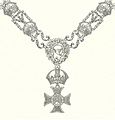
Collar of the Order of St. Stephen
(Hungary)
Collar of a Knight of the Order of St. Patrick
(Ireland)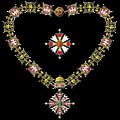
Collar of the Order of St. Prince Lazar
(Kingdom of Serbia, Kingdom of Yugoslavia and Royal House of Serbia)
Collar of the Order of St. Januarius—line drawing
(Naples)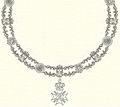
Keten van de Noorse Order of St. Olaf
(Norway)Star and Collar of the Order of the Thistle
(Scotland)
Collar of the Order of Carlos III
(Spain)
Collar of the Order of Isabella the Catholic
(Spain)
Collar of the Order of Civil Merit
(Spain)
Collar of the Order of the Golden Fleece
(Spain and Austrian Empire)
Collar of the Order of the Seraphim
(Sweden)
Collar of the Order of the Sword
(Sweden)
Collar of the Order of the Polar Star
(Sweden)
Collar of the Order of Vasa
(Sweden)
Collar the Order of Saint Joseph
(Tuscany and Würzburg)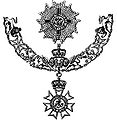
The Star and Collar of a Knight Grand Cross of the Order of St. Michael and St. George (United Kingdom)

Star and Collar of a Knight Grand Cross of the civil division of the Order of the Bath
(United Kingdom and Commonwealth)
Star and Collar of a Knight Grand Cross of the military division of the Order of the Bath
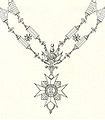
Collar of the Order of Saint Sylvester and the Golden Militia
(Vatican)
Line drawings from Maximilian Gritzner, 1893.
Collar of the Supreme Order of Christ
(Vatican)
Collar of the Order of the Garter
See also[]
- British honours system
- Collar (jewelry)
- Collar day
- Livery collar
- Orders of chivalry
- Heraldry
- Neckwear






























